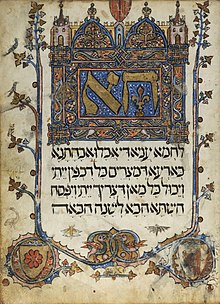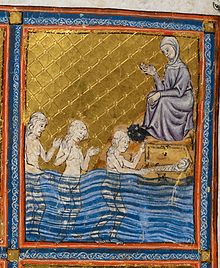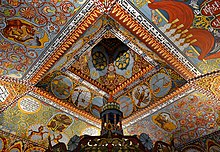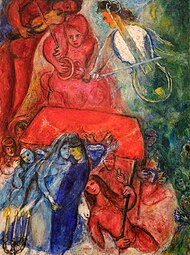
The menorah is a seven-branched candelabrum that is described in the Hebrew Bible and in later ancient sources as having been used in the Tabernacle and in the Temple in Jerusalem.

A synagogue, also called a shul or a temple, is a place of worship for Jews and Samaritans. It has a place for prayer where Jews attend religious services or special ceremonies such as weddings, bar and bat mitzvahs, choir performances, and children's plays. They also have rooms for study, social halls, administrative and charitable offices, classrooms for religious and Hebrew studies, and many places to sit and congregate. They often display commemorative, historic, or modern artwork alongside items of Jewish historical significance or history about the synagogue itself.
Michel Kikoïne was a Lithuanian Jewish-French painter who belonged to the Ecole de Paris art movement.

The Dura-Europos synagogue was an ancient synagogue uncovered at Dura-Europos, Syria, in 1932. The synagogue contains a forecourt and house of assembly with painted walls depicting people and animals, and a Torah shrine in the western wall facing Jerusalem. It was built backing on to the city wall, which was important in its survival. The last phase of construction was dated by an Aramaic inscription to 244 CE, making it one of the oldest synagogues in the world. It was unique among the many ancient synagogues that have emerged from archaeological excavations as the structure was preserved virtually intact, and it had extensive figurative wall-paintings, which came as a considerable surprise to scholars. These paintings are now displayed in the National Museum of Damascus.

Synagogue architecture often follows styles in vogue at the place and time of construction. There is no set blueprint for synagogues and the architectural shapes and interior designs of synagogues vary greatly. According to tradition, the Shekhinah or divine presence can be found wherever there is a minyan, a quorum, of ten. A synagogue always contains an Torah ark where the Torah scrolls are kept, called the aron qodesh by Ashkenazi Jews and the hekhal by Sephardic Jews.

The School of Paris refers to the French and émigré artists who worked in Paris in the first half of the 20th century.

Yitzhak Frenkel, also known as Isaac Frenkel or Alexandre Frenel, was an Israeli painter, sculptor and teacher. He was one of the leading Jewish artists of the l’École de Paris and its chief practitioner in Israel, gaining international recognition during his lifetime.

Ze’ev Raban (22 September 1890 – 19 January 1970), born Wolf Rawicki (Ravitzki), was a leading painter, decorative artist, and industrial designer of the Bezalel school style, and was one of the founders of the Israeli art world.

The Musée d'Art et d'Histoire du Judaïsme or mahJ is the largest French museum of Jewish art and history. It is located in the Hôtel de Saint-Aignan in the Marais district in Paris.
The Yeshiva University Center for Israel Studies reflects the longstanding relationship between Yeshiva University and Israel. It supports research, conferences, publications, museum exhibitions, public programs and educational opportunities that enhance awareness and study of Israel in all of its complexities. The center is led by Director Steven Fine, Professor of Jewish History at Yeshiva University, and Associate Director Joshua Karlip, Professor of Jewish History at Yeshiva University.
Beth Alpha is a sixth-century CE synagogue located at the foot of the northern slopes of the Gilboa mountains near Beit She'an, Israel. It is now part of Bet Alfa Synagogue National Park and managed by the Israel Nature and Parks Authority.

Steven Fine is a cultural historian specializing in 'Judaism in the Greco-Roman World' and a professor at Yeshiva University.
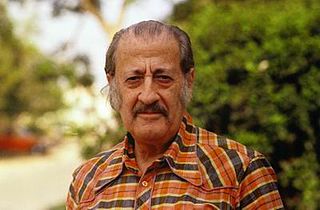
Moshe Castel was an Israeli painter.

Visual arts in Israel or Israeli art refers to visual art or plastic art created by Israeli artists or Jewish painters in the Yishuv. Visual art in Israel encompasses a wide spectrum of techniques, styles and themes reflecting a dialogue with Jewish art throughout the ages and attempts to formulate a national identity.
The “Tower of David Period” is the nickname which describes Israeli art during the 1920s. The nickname was coined as a result of the exhibition that took place in the Tower of David during that period. Instead of one artistic direction, this period was characterized by artistic works of conflicting styles, reflecting the worldview of the artists with regard to the social, political, and artistic reality within the Land of Israel and outside of it. Alongside the art created at “Bezalel”, which was characterized by decorative motifs and the influence of ars nova, the young Land-of-Israel artists produced works of art that reflected a variety of modernist influences.

The Magdala stone is a carved stone block unearthed by archaeologists in the Migdal Synagogue in Israel, dating to before the destruction of the Second Temple in Jerusalem in the year 70.
Temple Israel is the oldest of eleven Progressive synagogues in South Africa. It is a provincial heritage site, built in the Art Deco style by architect Hermann Kallenbach. It is located in the Johannesburg suburb of Hillbrow. It is an affiliate of the South African Union for Progressive Judaism (SAUPJ), which is part of the World Union for Progressive Judaism (WUPJ).
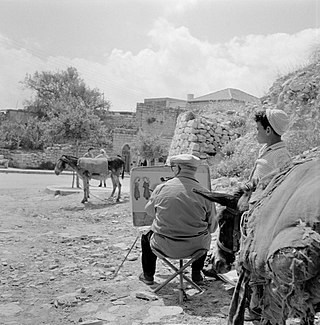
The Artists' Quarter in Safed, also known as the Artists' Colony; was founded after the capture of Safed, in the 1948 Arab–Israeli War. With the encouragement of the Safed municipality, a group of artists began to restore ruins in the Mamluk neighborhood of Harat al-Wata, on the border of the historic Jewish quarter, to build galleries and open exhibitions. The first artists to settle in Safed however arrived several years beforehand. The first to discover Safed's artistic aura was Isaac Frenkel Frenel in 1920 and following him Moshe Castel and Mordechai Levanon in the 1930s.

Ancient Jewish art, is art created by Jews in both the Land of Israel and in the Diaspora prior to the Middle Ages. It features symbolic or figurative motifs often influenced by biblical themes, religious symbols, and the dominant cultures of the time, including Egyptian, Hellenistic, and Roman art.

Qision was an ancient settlement in Upper Galilee, now an archaeological site in northern Israel, featuring the ruins of the settlement, including a public building, possibly an ancient synagogue, alongside an inscription dedicated to the Roman emperor Septimius Severus and his family commissioned by the local Jewish community.

